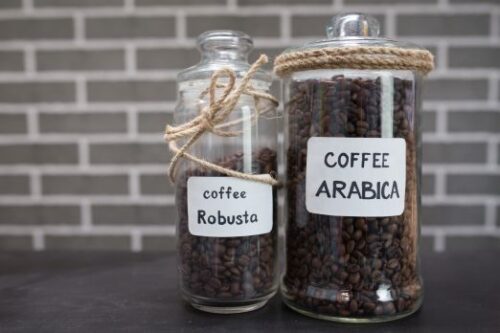Coffee enthusiasts worldwide embark on a captivating journey with every sip, exploring the vast range of flavors and scents concealed within coffee beans. From the deep, earthy notes of Sumatran beans to the exhilarating acidity of Ethiopian variants, the coffee realm is an intricate mosaic of diversity and indulgence.
Each region, climate, and cultivation technique gives rise to distinct varieties, possessing individual characteristics that tantalize the senses and arouse the palate. Whether you yearn for a luscious undertone of chocolate, a vibrant burst of fruitiness, or a silky-smooth caramel finish, the captivating realm of coffee bean varieties beckons you to relish an endless odyssey of taste exploration.

Arabica
These are highly respected for their exceptional quality and enjoy widespread popularity among coffee enthusiasts. Arabica coffee beans present a wide range of taste profiles with their nuanced flavors, pleasing acidity, and captivating aromas.
These profiles encompass fruity, floral, nutty, and chocolatey notes, offering extensive flavor possibilities. Additionally, Arabica beans generally possess lower caffeine levels than Robusta beans, making them a favored choice for those desiring a more moderate caffeine intake.
Robusta
In contrast, these are robust and resilient, rendering them well-suited for cultivation in various climates and at lower altitudes. Recognized for their pronounced and somewhat bitter taste relative to Arabica beans, they deliver a bold flavor experience.
Moreover, Robusta beans contain higher levels of caffeine, contributing to their reputation for providing a stimulating effect. They are frequently utilized in espresso blends to provide body, crema—a creamy foam—and a more noticeable caffeine kick. Additionally, they are valued for their ability to generate a luscious and enduring foam, enhancing the overall sensory experience.
Liberica
Arabica and Robusta are the most famous coffee bean varieties, but another type called Liberica has a distinct flavor profile. These have a unique taste, often described as smoky, woody, and sometimes floral. They are larger and have a slightly acidic taste that adds to their distinct character.
In the past, Liberica beans were affected by coffee leaf rust, which made them less available. However, there are initiatives to revive and promote their cultivation, so coffee lovers can again enjoy this exceptional variety.
Excelsa
These are cultivated in Southeast Asia and possess a distinct flavor profile. While some categorize them as a variant of the Liberica coffee beans, others classify them as a separate species.
These beans have a fruity and tart taste that evokes the essence of dark fruits like berries and plums. Many coffee connoisseurs prefer to incorporate Excelsa beans in their coffee blends as they add a layer of nuance and richness to the overall flavor.
Other Varieties
While most coffee enthusiasts are familiar with Arabica, Robusta, Liberica, and Excelsa coffee bean types, lesser-known varieties are just as fascinating. For instance, did you know there are sub-varieties within the Arabica family? These sub-varieties, such as Typica, Bourbon, Geisha (also known as Gesha), and Caturra, have unique tastes and qualities that set them apart.
Recently, there has been a rise in the popularity of these unique sub-varieties of coffee due to their outstanding and distinct flavor profiles. As a coffee enthusiast, try these lesser-known varieties to explore and experience new and exciting flavors.
Geographical Distribution
Specific regions across the globe cultivate various types of coffee beans that exhibit unique characteristics. The best Arabica beans are grown in high-altitude areas with cooler climates, such as Colombia, Ethiopia, Costa Rica, and Yemen.
Alternatively, Robusta beans grow better in regions with warmer temperatures and lower altitudes, such as Vietnam, Brazil, India, and Indonesia. The precise locations where coffee beans are grown contribute to the distinct flavors and attributes of coffee blends worldwide.
Flavor and Aroma Profiles
It may be common knowledge for some, but each variety of coffee beans boasts a unique taste and scent. Take Arabica beans, for instance. These beans are celebrated for their complexity, offering a variety of flavors ranging from floral and fruity to caramel and chocolate. Arabica beans can also provide a bright or smooth profile depending on how they’re grown and processed.
On the other hand, Robusta beans offer a stronger and richer taste, with hints of chocolate, earthiness, and even peanuts or spices. Finally, there are Liberica and Excelsa beans, celebrated for the bold and exotic characteristics that make them stand out.
Specialty Varieties
Coffee enthusiasts value specialty and uncommon coffee types in addition to the more common varieties. The Geisha (Gesha) variety is renowned for its exceptional flavor and has become synonymous with premium, specialty coffee.
Geisha coffee boasts floral and tea-like qualities, with a vibrant and complex flavor profile that sets it apart. Other unique and rare varieties, such as Maragogype (also known as Elephant beans) or Pacamara, are highly cherished for the distinctive attributes that make them stand out from the crowd.
Hybrid Varieties
Professionals in the breeding and farming sector of the coffee industry have been dedicating their efforts to creating hybrid coffee species that combine the most desirable characteristics of different types of coffee beans.
The ultimate objective is to improve various traits, such as disease resistance, yield, flavor, and more. Notable examples of hybrid coffee species include Catimor, Sarchimor, and Timor, which withstand pests and diseases without compromising the superior quality of the brewed coffee.
Conclusion
Coffee roasters and enthusiasts often blend different types of coffee beans to achieve a balanced and exceptional flavor. This method helps them extract the benefits of various beans and achieve their desired taste profile.
Choosing the right coffee beans is crucial for a satisfying and enjoyable coffee experience. Rather than choose solely on recommendations, know your preferred taste first, be it sweet, earthy, light-bodied, or heavy-bodied. Then, consider the amount of caffeine you want.
Next, check the roast date; the ideal window is four days to a month after roasting. Be mindful of misleading labels and pick starter kits when you’re brewing at home for the first time.
Ultimately, shop from a reputable supplier who knows which beans work best with your coffee machine or tools.





